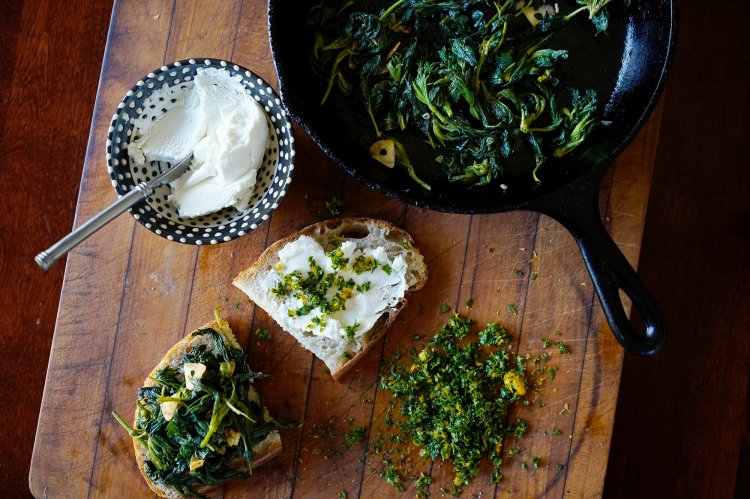When my then-young family lived in England, we’d often take a Sunday afternoon summer walk, wending our way through the combined coastal and woodland landscapes of our Norfolk home. For strategic refueling purposes, we’d routinely fix on a circular path that started and ended at a pub, but along the way, my kids always had their eyes peeled for ripe bramble berries. The quest for these dark purple treats, which are the shape and consistency of raspberries, was just the ticket for keeping the whining to a minimum along winding 5-mile walks.
Unfortunately for my children’s ankles, brambles thrive in the same unruly, wild conditions as stinging nettles do. When hollow hairs (called trichomes) located on the leaves and stems of nettles meet human skin, they act like tiny hypodermic needles, injecting histamine and other chemicals into the flesh. The ensuing stinging sensation is unpleasant, but nothing more unless you’re allergic to these chemicals. Luckily, my kids were not, and their rashes were always soothed by my husband’s trick – passed down from his own parents – of rubbing the leaf of a nearby dock plant over the affected area.
I outlined this localized remedy to the attendant of the Whatley Farm stand at the Brunswick Farmers’ Market last week. As I did, I was using long-handled tongs to shovel the stinging nettles she and her colleagues had foraged from a wild patch near the Bowdoinham farm into a reusable cloth bag she also had for sale. Blanching them also deactivates the toxins so that you that you can then use them as you would any other hearty green.
In her book, “Dandelion & Quince: Exploring the Wide World of Unusual Vegetables, Fruits and Herbs,” Michelle McKenzie says to look for young nettle plants that have not flowered as older plants contain calcium oxalate that can feel sandy and gritty in the mouth. Here’s how to handle them, she says:

Always wear gloves when handling raw nettle; otherwise, you’ll feel the sting. Brianna Soukup/Staff Photographe
Wear gloves.
Separate the leaves from any woody stalks – the tender ones are okay to eat, compost the woody ones.
Wash them in a big basin of cold water.
Blanch them in boiling, well-salted water.
Drain them completely, as any water left in the greens will leach an unattractive blackish-green color into whatever you cook with them.
Nettles are packed with both minerals and chlorophyll. Blanched, they taste earthy, meaty and green. Balanced with some fat and brightened with acid, nettles are as indulgent as they are healthy, McKenzie says. She suggests chopping them finely and folding them into softened butter to top a steak or elevate grilled bread; tossing them with pasta, chiles, lemon, olive oil and shaved pecorino cheese; or spooning them into ramekins, then topping them with a freshly cracked egg, cream, salt and pepper, and baking them until the egg is set.
Susan Flynn, co-owner of the Biddeford-based Four Star Fresh and producer of locally sourced, handcrafted pasta, polenta, sauces and salsas, buys her nettles from Fresh Pickins Farm at the Kennebunk Farmers’ Market. Flynn buys loads of nettles this time of year – probably the only time of year you can get them. She blanches them to set the color as she does with basil, purees them in a food processor, and freezes the puree so that all year round she can make nettle gnudi (light, Italian dumplings) and include them with kale, Swiss chard and spinach in her super greens ravioli. Flynn says a simple tomato sauce works best with both the nettle pastas she makes and sells at several locations around southern Maine.
“You’ve gone to all the trouble to make what is essentially a weed into a beautiful dish, let the flavor of the nettles shine through,” Flynn said.
CHRISTINE BURNS RUDALEVIGE is a food writer, recipe developer and tester and cooking teacher in Brunswick, and the author of “Green Plate Special,” a cookbook from Islandport based on these columns. She can be contacted at cburns1227@gmail.com.

Goat cheese and nettle sandwich. It’s easy to tame the sting and eat this delicious weed. Brianna Soukup/Staff Photographer
Sautéed Nettle Sandwiches with Goat Cheese and Gremolata
This is an adaptation of a recipe I found in “Dandelion & Quince: Exploring the Wide World of Unusual Vegetables, Fruits and Herbs” by Michelle McKenzie. I’d never eaten a sautéed greens sandwich before, and now I can’t keep enough sautéed nettles in the fridge to satisfy my cravings.
Makes 2 sandwiches
4 tablespoons olive oil
2 cloves garlic, peeled and thinly sliced
1/4 to 1/2 teaspoon smoky red pepper flakes like Aleppo, Marash or Urfa Biber
1 packed cup blanched nettles
Salt
1/2 cup parsley leaves
1/4 teaspoon lemon zest
1/4 teaspoon orange zest
4 slices hearty bread
2 ounces goat cheese
Heat 3 tablespoons of the olive oil with the garlic and red pepper flakes in a large skillet over medium heat. Cook until the garlic slivers are very lightly golden. Add the blanched nettles and stir to combine. Cook for 2 minutes until the nettles are warmed through. Season with salt, transfer greens to a bowl.
Finely chop the parsley with the citrus zests and 1/4 teaspoon salt. Set aside.
Brush 1 side of each piece of bread with the remaining 1 tablespoon oil. Place the skillet over medium high heat, and add the bread, oiled side down. Cook until the bottoms are toasted. Transfer the bread to a cutting board. Spread half of the goat cheese on the non-toasted side of 2 of the slices. Divide the greens and gremolata between the 2 sandwiches. Top with the other 2 slices, toasted sides out, and serve immediately.
Send questions/comments to the editors.



Comments are no longer available on this story